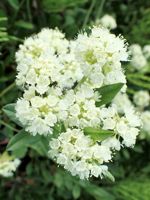Mon-Fri 9am - 5pm Mountain time
Sulphur-Flower Buckwheat vs Bluebunch Wheatgrass
Eriogonum umbellatum
Pseudoroegneria spicata (Agropyron spicatum)
CUSTOM GROW
CUSTOM GROW
Sulphur-Flower Buckwheat is a native perennial wildflower known for its dense clusters of cream to yellow flowers. The long-lasting blooms persist from late spring into summer, providing an extended nectar source for a variety of pollinators. The flower buds are often red-tinted before opening. As the blooms age, they shift to orange or red, adding seasonal interest and making them well-suited to dried flower arrangements. Its seeds are also eaten by birds, adding to its ecological value.
Depending on climate and conditions, Sulphur-Flower Buckwheat may be evergreen to semi-evergreen, or its foliage may turn red during fall. Its deep roots and spreading growth stabilize rocky or sandy soils, making it useful for erosion control. Exceptionally hardy once established, it requires little care and thrives in challenging environments, making it an excellent choice for pollinator gardens, naturalization, and ecological restoration projects.
Bluebunch Wheatgrass is a native perennial bunchgrass common across prairies, foothills, and open woodlands. Longer-lived than many other grass species, it develops deep, fibrous roots that stabilize soils and make it drought-tolerant once established. It is a cool-season grass, growing most actively in spring and fall and slowing during the heat of summer.
This hardy grass provides excellent forage for deer, elk, and bighorn sheep, and is especially palatable to livestock. Its seeds feed birds and small mammals, while its bunching growth offers protective cover for ground-nesting birds such as sparrows and sage-grouse, as well as shelter for small mammals. Bluebunch Wheatgrass is well-suited to rangeland & prairie restoration, naturalization, and erosion control projects.

